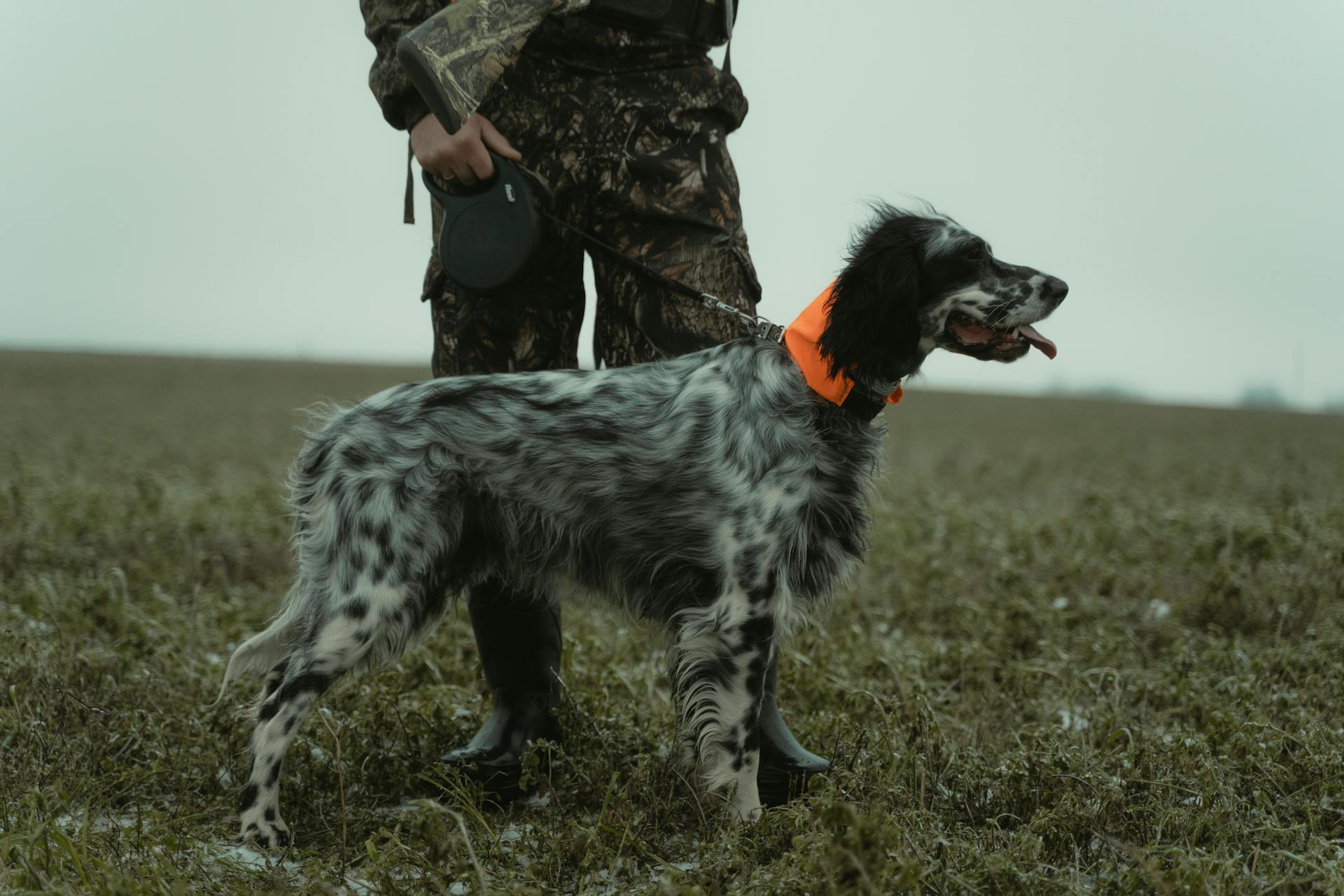
The Saluki is an ancient dog breed with a rich history dating back thousands of years. They originated in the Middle East, specifically in present-day Iraq, Iran, and Egypt.
These dogs were bred to hunt small game, such as gazelles and hares, and were highly valued for their speed and agility. Their slender build and long legs made them well-suited for this purpose.
The Saluki's independent nature can sometimes make them challenging to train, but with patience and consistency, they can learn to obey commands.
Additional reading: Saluki Dog Origin
Saluki Care
A Saluki needs a large, securely fenced yard to run around in - at least 300 to 400 feet in length or width. They'll easily jump a fence that's less than five to six feet high, so be sure to invest in a sturdy one.
They're indoor dogs and require soft, cushioned bedding to prevent calluses from forming. Place their food well out of reach, behind closed doors or up about seven feet.
To keep your Saluki happy and healthy, provide at least two hours of activity every day. They love using their powerful legs to sprint outside.
Salukis are intelligent and learn quickly, but they can be stubborn. Keep training sessions short, fun, and interesting to hold their attention.
Here are the different types of Salukis and their coat needs:
- Feathered Salukis have long fur around their ears and tail and require regular brushing to prevent mats.
- Smooth Salukis have short fur and don't shed as much as feathered Salukis.
Regular grooming is essential for Salukis. Brush them once or twice a week to prevent matting, and keep their ears and tail clean to prevent dirt and food from getting stuck.
Saluki Personality and Temperament
The Saluki is a unique breed with a distinct personality. They're aloof with strangers, but devoted to their family.
They're gentle and thrive on quiet companionship, bonding closely with a single person. This can lead to separation anxiety if they're left alone for too long.
Socialization is key to helping your Saluki puppy grow up to be a well-rounded dog. They should be exposed to many different people, sights, sounds, and experiences when they're young.
Salukis are sensitive dogs and pick up on tensions in the home, so it's essential to maintain a calm and peaceful environment. They're also fastidious about personal cleanliness, much like cats.
They generally get along with other dogs, especially other Salukis or sighthounds, but may be shy if they're not socialized properly. With proper socialization, they'll be confident and friendly around others.
They love comfort and enjoy being pampered with soft bedding and access to furniture.
Saluki Health and Nutrition
Salukis are generally a hardy breed, but like all dogs, they can be prone to certain health issues. Anesthesia sensitivity is a concern due to their low body fat, but modern drugs and veterinarians' awareness have minimized this risk.
Hemangiosarcoma, cardiomyopathy, and hypothyroidism are potential health problems in Salukis. Dilated cardiomyopathy is the most common form of cardiomyopathy, affecting young to middle-aged males in larger breeds.
To minimize the risk of these health issues, it's essential to work with a reputable breeder who has performed health clearances on both parents. Look for clearances from the Orthopedic Foundation for Animals (OFA) for cardiac and thyroid disease.
Here's a quick rundown of the recommended daily food intake for Salukis:
Salukis are known to be picky eaters, so be mindful of their appetite and adjust their food portions accordingly. Fresh water should always be available to this large, active breed.
Diet and Nutrition
Salukis may need to eat up to 2.75 cups of food daily, split into at least two meals.
Their appetite can vary greatly from dog to dog, so some may be picky eaters.
To prevent weight gain and related issues, it's essential to monitor their food intake, especially for those with increased appetites.
Salukis are known to be highly active, so they require a lot of energy to maintain their sleek physique.
A high-quality, complete, and balanced dog food is essential for their overall health and well-being.
Fresh water should be available at all times to this large, active breed.
Their daily diet should consist of 90% dog food and 10% treats, as recommended by experts.
Feeding them twice daily, morning and evening, can help maintain a healthy eating schedule.
Their appetite may vary, so some may eat eagerly when given a meal, while others may eat when they choose.
It's crucial to measure out their food portions and limit their treats to prevent obesity, which is a common issue in this breed.
Consulting with a veterinarian can help determine the proper portion to feed your Saluki based on ideal body weight and life stage.
Consider reading: When Can I Breed My Female Dog
Health
The Saluki is a generally healthy breed, but like all breeds, it can be prone to certain health issues. They can live up to 17 years, which is a testament to their overall hardiness.
One health issue that's worth mentioning is anesthesia sensitivity. Salukis have a low level of body fat, which makes them more sensitive to anesthesia and certain other drugs. Fortunately, modern drugs have properties that minimize this risk, and most veterinarians are aware of the special needs of sighthounds like the Saluki.
Hemangiosarcoma, a malignant cancer, can affect Salukis. It's found in the lining of blood vessels and the spleen.
Cardiomyopathy, a disease of the heart muscle, can also occur in Salukis. It comes in two forms: dilated and hypertrophic. Dilated cardiomyopathy causes the heart's main pumping chambers to enlarge, while hypertrophic cardiomyopathy causes an increase in heart muscle mass.
Hypothyroidism, an abnormally low level of the hormone produced by the thyroid gland, can affect Salukis. Signs of the disease include infertility, obesity, mental dullness, drooping eyelids, low energy levels, irregular heat cycles, coarse and brittle fur, and tough, dark skin.
If you're buying a Saluki puppy, it's essential to find a reputable breeder who provides health clearances for both parents. Look for health clearances from the Orthopedic Foundation for Animals (OFA) for cardiac and thyroid disease.
Suggestion: American Pitbull Terrier Muscle
Behavior and Training
Salukis are known to be independent and aloof, which can make them somewhat difficult to train. They like to think for themselves and may need more persuasion than other breeds.
Early socialization is crucial to ensure they get along with a variety of people and pets. This should start early in life to help them become confident and calm in new situations.
Salukis respond well to positive reinforcement like treats and praise, making training a more enjoyable experience for both you and your dog.
Training a good recall is very important in this breed, but it shouldn't be relied upon without distractions. This means you'll need to practice recall in various situations to help your Saluki focus.
Salukis can be challenging to train, but starting obedience classes when they're a puppy can help. The Saluki Club of America recommends using positive reinforcement training methods for the most effective results.
If you're planning to introduce a Saluki to cats, it's best to find a breeder who has reared their puppies with cats or make slow and patient introductions. This will help prevent any potential conflicts.
Salukis are sprinters at heart and need at least one to two hours of daily exercise, including free-running in safe locations. This will help them get the physical and mental stimulation they need.
Between exercise periods, Salukis are generally laidback and relaxed in the house, making them a great companion for adults. However, they may not be the most kid-friendly breed due to their preference for calm and quiet environments.
If this caught your attention, see: Will Shiba Inu Reach 1 Cent
Saluki Ownership and Adoption
If you're considering bringing a Saluki into your life, it's essential to do your research and find a reputable breeder or rescue organization. Expect to pay between $1,000 to $3,000 for a purebred puppy from a US breeder.
Before working with a breeder, make sure to check out organizations like the Saluki Club of America, Dogs for Life Foundation, and Saluki Rescue International, which provide breeder information and rescue efforts for this breed. You can also try AKC Marketplace for more breeder listings.
If you're interested in adopting an adult Saluki, consider reaching out to rescue groups like STOLA — Saluki Tree of Life Alliance or Saluki Club of America Rescue, which often have dogs that are already trained and ready for a new home.
Check this out: American Kennel Club Lancashire Heeler
Adopting or Buying a Dog
If you're looking to bring a Saluki into your life, you have two main options: adopting or buying. Saluki dogs are rare in the U.S., so you may need to look overseas for a puppy or rescue.
Adopting a Saluki can be a great option, especially if you're looking for an adult dog that's already gone through the destructive puppy stage. Rescue groups like STOLA — Saluki Tree of Life Alliance and Saluki Club of America Rescue often have adult Salukis in need of a forever home.
If you do decide to buy a Saluki, be prepared to pay between $1,000 to $3,000 for a purebred puppy. However, make sure to do your research and find a reputable breeder who takes good care of their dogs and puppies.
Here are some organizations to consider when searching for a breeder or rescue group:
- Saluki Club of America
- Dogs for Life Foundation (Saluki)
- Saluki Rescue International
- Pure Elegance Saluki Puppies (U.S. breeder)
- AKC Marketplace
- STOLA — Saluki Tree of Life Alliance
- Saluki Club of America Rescue
Ideal Owner
To be a Saluki owner, you'll need to have some experience with sighthound breeds, as they can be quite unique. Salukis are known to be elegant yet thuggish, so you'll need to be prepared for a dog that's full of contradictions.
They won't tolerate being manhandled or fussed over when they're not in the mood. Salukis require a calm and peaceful environment, which means a home with older, respectful children or adult-only households is ideal.
They're not suited for loud or rambunctious households, unless it's them causing the commotion. If you value your inner peace, a Saluki might be the perfect companion for you.
Frequently Asked Questions
Is a Saluki faster than a Greyhound?
A Saluki is faster over longer distances, with a recorded speed of 68.8 km/h, while a Greyhound is faster over shorter distances up to 800 meters. This makes the Saluki the fastest dog breed overall, according to Guinness World Records.
Is a Saluki faster than a cheetah?
While Salukis are not faster than cheetahs in short sprints, they excel at endurance running and can catch prey over longer distances. In fact, Salukis are bred for hunting gazelle, which requires sustained speed and endurance.
How much does a Saluki dog cost?
A Saluki puppy typically costs around $2,500. This initial investment is a great starting point for bringing home a new furry friend.
Featured Images: pexels.com

